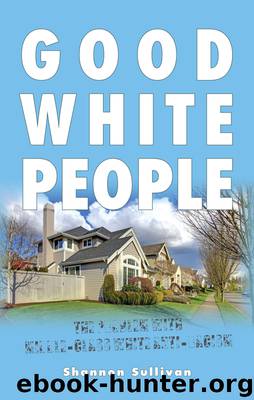Good White People by Sullivan Shannon

Author:Sullivan, Shannon
Language: eng
Format: epub
Publisher: State University of New York Press
Published: 2014-01-02T16:00:00+00:00
White supremacists are right about one thing: white parents need to openly discuss race, especially whiteness, with their white children. Of course, white allied parents need to do this in ways that challenge rather than promote white domination, but white supremacists nevertheless have something valuable to teach other white people about the importance of explicitly talking about whiteness with their kids. When providing examples of how white allied parents might do this, I was struck by their similarity to the suggestions made by white supremacist parents. Even though the content of the two sets of suggestions is different, their form is virtually identical: don’t let whiteness be invisible, and identify and discuss race in all sorts of situations and places where it usually isn’t done. And in some cases, the content of the two suggestions isn’t even that different. For example, the worry about unconscious media messages concerning race and the resulting advice to count and discuss the number of people of different races portrayed on television are eerily similar to that of white supremacists. The difference in this case, of course, is that white allied and white supremacist parents have very different ideas about what is subversive about the racial environment provided by mainstream media and certainly about what count as desirable outcomes of discussing media portrayals of race. But what is the same is the belief that white parents should not leave the racial development of their white children to chance. White parents need to counter what contemporary society teaches about race by openly discussing racial matters with their kids.
As important as this advice is, however, it ultimately cannot be sufficient for racial justice movements. More discussion of race, as if white allies could talk the world free of racial oppression, cannot be the entire solution to problems of racism. As I have suggested, just as significant as the role of words in white parents’ interaction with their white children is the role of their racially disciplined and normalized bodies. Not everything can be said, about race or any other topic, and the bodily unsaid—located in bodily habits and behavior—can convey a great deal. Many of the bodily messages conveyed about race will not be understood by a young child—although they can still impact her developing raced and racist unconscious—but a surprising number of them are.
This point is evident in the example of a white mother with two white children, ages seven and two and a half, who would wheel the toddler around the streets of New York in a stroller.65 The mother habitually steered around the panhandlers on her neighborhood street, almost all of whom were black men. As she explains, she did so neither because she feared them nor because they aggressively approached her for money, but because she did not have change to give them and did not want her children to think that she was unkind. One day at home, the toddler suddenly announced to his mother that “black men are bad.” The toddler’s parents were horrified.
Download
This site does not store any files on its server. We only index and link to content provided by other sites. Please contact the content providers to delete copyright contents if any and email us, we'll remove relevant links or contents immediately.
| General | Discrimination & Racism |
Nudge - Improving Decisions about Health, Wealth, and Happiness by Thaler Sunstein(6657)
iGen by Jean M. Twenge(4714)
The Fire Next Time by James Baldwin(4364)
Adulting by Kelly Williams Brown(3700)
The Sports Rules Book by Human Kinetics(3611)
The Hacking of the American Mind by Robert H. Lustig(3597)
The Ethical Slut by Janet W. Hardy(3528)
Captivate by Vanessa Van Edwards(3319)
Mummy Knew by Lisa James(3179)
In a Sunburned Country by Bill Bryson(2963)
The Worm at the Core by Sheldon Solomon(2943)
Ants Among Elephants by Sujatha Gidla(2937)
Suicide: A Study in Sociology by Emile Durkheim(2620)
The Slow Fix: Solve Problems, Work Smarter, and Live Better In a World Addicted to Speed by Carl Honore(2582)
Humans of New York by Brandon Stanton(2387)
Handbook of Forensic Sociology and Psychology by Stephen J. Morewitz & Mark L. Goldstein(2383)
Blackwell Companion to Sociology, The by Judith R. Blau(2324)
The Happy Hooker by Xaviera Hollander(2279)
Outliers by Malcolm Gladwell(2270)
